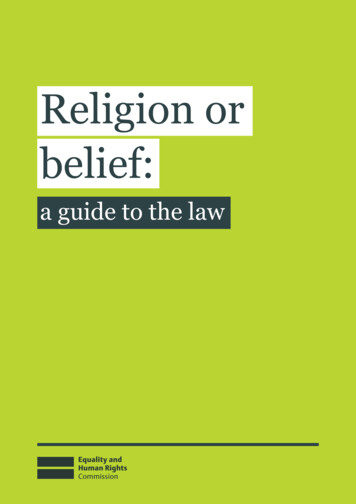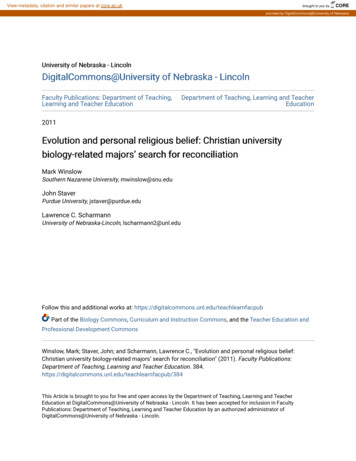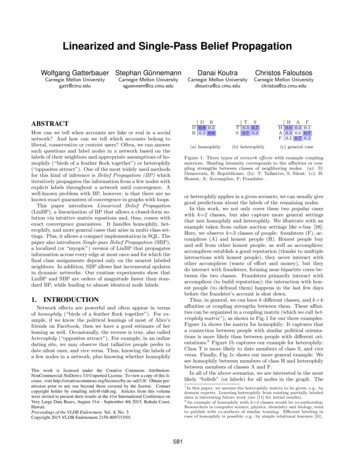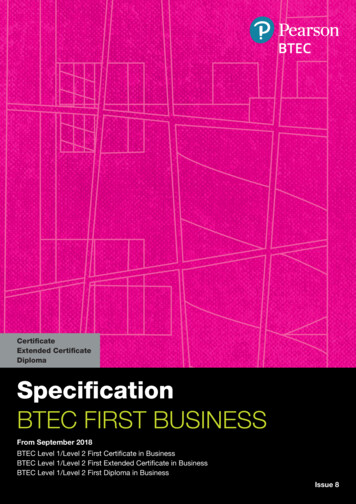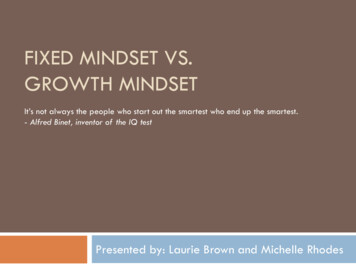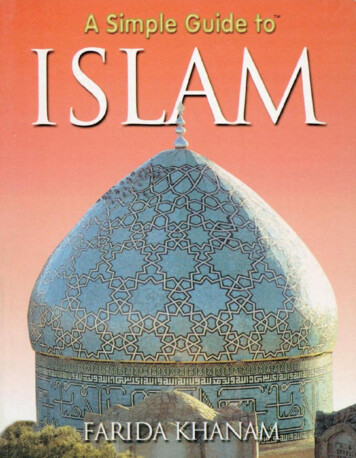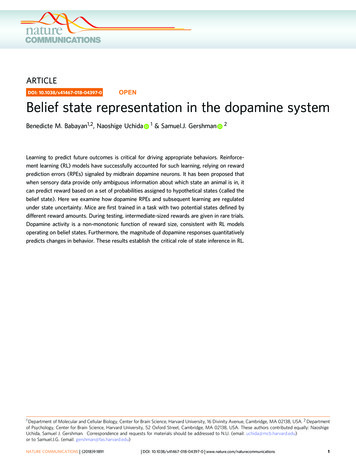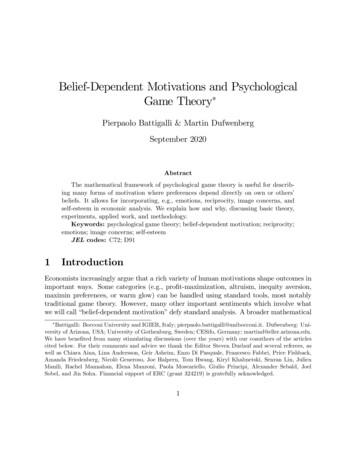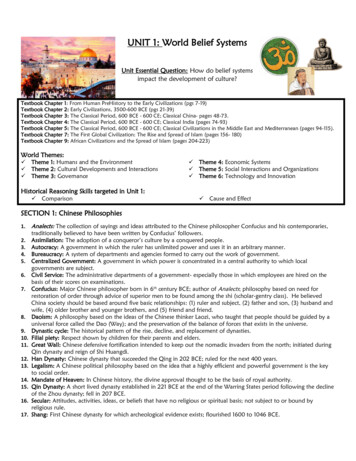
Transcription
UNIT 1: World Belief SystemsUnit Essential Question: How do belief systemsimpact the development of culture?Textbook ChapterTextbook ChapterTextbook ChapterTextbook ChapterTextbook ChapterTextbook ChapterTextbook Chapter1: From Human PreHistory to the Early Civilizations (pgs 7-19)2: Early Civilizations, 3500-600 BCE (pgs 21-39)3: The Classical Period, 600 BCE - 600 CE; Classical China- pages 48-73.4: The Classical Period, 600 BCE - 600 CE; Classical India (pages 74-93)5: The Classical Period, 600 BCE - 600 CE; Classical Civilizations in the Middle East and Mediterranean (pages 94-115).7: The First Global Civilization: The Rise and Spread of Islam (pages 156- 180)9: African Civilizations and the Spread of Islam (pages 204-223)World Themes: Theme 1: Humans and the EnvironmentTheme 2: Cultural Developments and InteractionsTheme 3: Governance Theme 4: Economic SystemsTheme 5: Social Interactions and OrganizationsTheme 6: Technology and InnovationHistorical Reasoning Skills targeted in Unit 1: Comparison Cause and EffectSECTION 1: Chinese .17.Analects: The collection of sayings and ideas attributed to the Chinese philosopher Confucius and his contemporaries,traditionally believed to have been written by Confucius’ followers.Assimilation: The adoption of a conqueror’s culture by a conquered people.Autocracy: A government in which the ruler has unlimited power and uses it in an arbitrary manner.Bureaucracy: A system of departments and agencies formed to carry out the work of government.Centralized Government: A government in which power is concentrated in a central authority to which localgovernments are subject.Civil Service: The administrative departments of a government- especially those in which employees are hired on thebasis of their scores on examinations.Confucius: Major Chinese philosopher born in 6th century BCE; author of Analects; philosophy based on need forrestoration of order through advice of superior men to be found among the shi (scholar-gentry class). He believedChina society should be based around five basic relationships: (1) ruler and subject, (2) father and son, (3) husband andwife, (4) older brother and younger brothers, and (5) friend and friend.Daoism: A philosophy based on the ideas of the Chinese thinker Laozi, who taught that people should be guided by auniversal force called the Dao (Way); and the preservation of the balance of forces that exists in the universe.Dynastic cycle: The historical pattern of the rise, decline, and replacement of dynasties.Filial piety: Respect shown by children for their parents and elders.Great Wall: Chinese defensive fortification intended to keep out the nomadic invaders from the north; initiated duringQin dynasty and reign of Shi Huangdi.Han Dynasty: Chinese dynasty that succeeded the Qing in 202 BCE; ruled for the next 400 years.Legalism: A Chinese political philosophy based on the idea that a highly efficient and powerful government is the keyto social order.Mandate of Heaven: In Chinese history, the divine approval thought to be the basis of royal authority.Qin Dynasty: A short lived dynasty established in 221 BCE at the end of the Warring States period following the declineof the Zhou dynasty; fell in 207 BCE.Secular: Attitudes, activities, ideas, or beliefs that have no religious or spiritual basis; not subject to or bound byreligious rule.Shang: First Chinese dynasty for which archeological evidence exists; flourished 1600 to 1046 BCE.
18. Shi Huangdi: Founder of the brief Qin dynasty in 221 BCE; unified China, and began construction of the Great Wall ofChina.19. Silk Roads: A system of ancient caravan routes across Central Asia, along which traders carried silk and other tradegoods.20. Yin and yang: In Chinese thought, the two powers that govern the natural rhythms of life.21. Zhou Dynasty: A Chinese dynasty that overthrew the Shang in 1027 BCE. The Zhou adopted much of the Shangculture, and justified their right to rule through a Mandate of Heaven; flourished 1122 to 256 BCE.SECTION II: Hinduism and Buddhism22. Ahimsa: Hindu belief in nonviolence.23. Ashoka: Ruler of the Mauryan Empire (273-232 BCE); Grandson of Chandragupta Maurya; completed conquests ofIndian subcontinent; converted to Buddhism and sponsored spread of Buddhism throughout his empire.24. Brahma: A Hindu god considered the creator of the world.25. Buddha: Creator of a major Indian and Asian religion; born Siddhartha Guatama in 6 th century BCE as son of local ruleramong Aryan tribes located near Himalayan’s; became an ascetic; found enlightenment under bodi tree; taught thatenlightenment could be achieved only by abandoning desires for all earthly things.26. Buddhism: A religion indigenous to the Indian subcontinent, it is largely based on the teachings, traditions, practices andbeliefs of Siddhartha Guatama.27. Caste: In traditional Indian society, unchangeable social group into which a person is born.28. Chandragupta Maurya: Founder of Maurya dynasty; established first empire in Indian subcontinent; first centralizedgovernment since Harappan civilization; ruled from 322-298 BCE).29. Dharma: In Hinduism and Buddhism, an individual’s religious and moral duties. In Hinduism, the caste position andcareer determined by a person’s birth; Hindu culture required that one accept one’s social position and performoccupation to the best of one’s ability in order to have a better situation in the next life.30. Eightfold Path: According to Buddha, the path to nirvana or enlightenment and consisting of RightView/Understanding, Right Thought, Right Speech, Right Action, Right Livelihood, Right Effort, Right Mindfulness,Right Concentration.31. Enlightenment: In Buddhism, a state of perfect wisdom in which one understands basic truths about the universe.32. Four Nobel Truths: In Buddhism, the principles that are the essence of Buddha’s teachings: life is suffering; desires causesuffering; the annihilation of desires can relieve suffering; the way to do this is by following the Eightfold Path.33. Gupta Dynasty: Succeeded the Kushans in the 3rd century CE; built empire that extended to all but the southern regionsof Indian sub-continent; less centralized than Mauryan empire.34. Gurus: Originally referred to as Brahmans who served as teachers for the princes of the imperial court of the Guptas.35. Himalayas: Mountain region marking the northern border of the Indian subcontinent; site of the Aryan settlements thatformed small kingdoms or warrior republics.36. Hinduism: The predominate religion of the Indian subcontinent. It is currently the world’s 3 rd largest religion.37. Jainism: A religion founded in India in the sixth century BCE, whose members believe that everything in the universehas a soul and therefore should not be harmed.38. Karma: In Hinduism and Buddhism, the totality of the good and bad deeds performed by a person, which is believedto determine his or her fate after rebirth.39. Mahayana: A sect of Buddhism that offers salvation to all and allows popular worship.40. Matriarchal: Relating to a social system in which the mother is head of the family.41. Mauryan Dynasty: Established in Indian subcontinent in 4th century BCE following invasion by Alexander the Greatfrom Greece.42. Moksha: In Hinduism, freedom from the endless cycle of rebirth into a state of bliss, union with Brahman. This is theultimate goal of life.43. Monsoons: Seasonal winds crossing Indian subcontinent and Southeast Asia; during summer bring rains.44. Nirvana: In Buddhism, the state of enlightenment, a state of tranquility.45. Patriarchal: Relating to a social system in which the father is head of the family.46. Reincarnation: In Hinduism and Buddhism, the process by which a soul is reborn continuously until it achieves perfectunderstanding.47. Religious toleration: A recognition of people’s right to hold differing religious beliefs.48. Sanskrit: The sacred and classical Indian language.
49. Shiva: A Hindu god considered the destroyer of the world; worshipped as the personification of cosmic forces ofchange.50. Siddhartha Gautama: The founder of Buddhism, known as Buddha (“awakened one”).51. Stupas: Stone shrines built to house pieces of bone or hair and personal possessions said to be relics of the Buddha;preserved Buddhist architectural forms.52. Tamil: A language of southern India, also, the people who speak that language.53. Theravada: A sect of Buddhism focusing on the strict spiritual discipline originally advocated by the Buddha.54. Untouchables: Low social caste in Hindu culture; performed tasks that were considered polluting- street sweeping,removal of human waste, and tanning.55. Varnas: Clusters of caste groups in Aryan society; four social castes- Brahmans (priests), warriors, merchants, andpeasants; beneath four Aryan castes were group of socially untouchable Dalits.56. Vishnu: A Hindu god considered the preserver of the world; god of sacrifice; widely worshippedSECTION III: Zoroastrianism57. Monotheism: belief in one god58. Zoroastrianism: Animist religion that saw material existence as battle between forces of good and evil; stressed theimportance or moral choice; righteous lived on after death in “House of Song”; chief religion of Persian empire.SECTION IV: Judaism59. Covenant: A binding agreement.60. Diaspora: The dispersal of the Jews from their homeland in Palestine- especially during the period of more than 1,800years that followed the Romans’ destruction of the Temple in Jerusalem in 70 CE.61. Ten Commandments: Set of Biblical laws relating to ethics and worship, which play a fundamental role in Judaism andChristianity.62. Prophet: In a religion, an individual who claims to speak the word of god.SECTION V: ChristianityChristianity: Worldwide monotheistic religion based on the life and teachings of the prophet Jesus.Coptic: Christian sect of Egypt; tended to support Islamic invasions of this area in preference to Byzantine rule.Golden Rule: In the teachings of Jesus Nazareth, one should treat others, as one would like others to treat oneself.Heresy: Religious belief that is contrary to the official teachings of the Church.Martyr: Somebody who suffers persecution and death for refusing to renounce, or accept, a belief or cause, usuallyreligious.68. Messiah: Savor or liberator of a people in the Jewish, Christian or Islamic faiths.69. Pope: The Bishop of Rome and the leader of the worldwide Catholic Church.63.64.65.66.67.SECTION VI: Islam70. Abbasid: Dynasty that succeeded the Umayyads as caliphs within Islam; came to power in 750 CE.71. Abu Bakr: The first caliph or leader of the Muslim faithful elected after Muhammad’s death in 632. Renown for hisknowledge of the nomadic tribes who then dominated the Islamic community.72. Ali: Cousin and son-in-law of Muhammad; one of orthodox caliphs; focus of Shi’a Islam.73. Allah: The Arab term for the high god in pre-Islamic Arabia that was adopted by the followers of Muhammad and theIslamic faith.74. Baghdad: Capital of Abbasid dynasty located in Iraq near ancient Persian capital.75. Battuta, Ibn: Born 1304; Arab traveler who described African societies and cultures in his travel records.76. Bedouin: Nomadic pastoralists of the Arabian peninsula; culture based on camel and goat nomadism; early converts toIslam.77. Caliph: The political and religious successor to Muhammad.
78. Damascus: Syrian city that was capital of Umayyad caliphate.79. Dhimmi: Literally “people of the book”; applied as inclusive term to Jews and Christians in Islamic territories; laterextended to Zoroastrians and even Hindus.80. Dhows: Arab sailing vessels with triangular or lateen sails; strongly influenced European ship design.81. Five Pillars: The obligatory religious duties of all Muslims; confession of faith, prayer, fasting during Ramadan, zakat,and hajj.82. Hadith: Traditions of the prophet Muhammad.83. Hajj: A Muslim’s pilgrimage to the holy city of Mecca, to worship Allah at the Ka’ba.84. Hijra: The migration or journey of the Islamic prophet Muhammad and his followers from Mecca to Medina.85. Islam: Monotheistic; second largest world religion.86. Jihad: Struggles; often used for wars in defense of the faith, but also a term to indicate personal quests for religiousunderstanding.87. Jizya: Tax paid by all nonbelievers in Islamic territories.88. Ka’ba: Most revered religious shrine in pre-Islamic Arabia; located in Mecca; focus of obligatory annual truce amongBedouin tribes; later incorporated as important shrine in Islam; Muslims believe it was a house of worship built byAbraham and his son Ishmael.89. Khadijah: First wife of the prophet Muhammad, who had worked for her as a trader.90. Maghreb: The Arabic word for western North Africa.91. Mawali: Converts to Islam.92. Mecca: City located in mountainous region along the Red Sea in Arabian peninsula; founded by Umayyad clan; site ofKa’ba; original home of Muhammad; location of chief religious pilgrimage point in Islam.93. Medina: Town located northeast of Mecca; grew date palms whose fruit was sold to Bedouin’s; became refugee forMuhammad following flight from Mecca.94. Mosque: A place of worship for followers of Islam.95. Muhammad: Prophet of Islam; born c. 570 to Banū Hashim clan of Quraysh tribe in Mecca; raised by father’s family;received revelations from Allah in 610 CE and thereafter; died in 632.96. Muslim: Term for individuals who practice the Islamic Faith.97. Qu’ran (Koran): Recitations of revelations received by Muhammad; holy book of Islam.98. Ramadan: Islamic month of religious observance requiring fasting from dawn to sunset.99. Sassanian Empires: The dynasty that rule Persia (contemporary Iran) in the centuries before the rise of Muhammad andthe early decades of Islamic expansion; mainly Zoroastrian.100.Sect: a group with distinctive religious, political or philosophical beliefs, often an offshoot of a larger religious group.101.Sharia: Islamic law; defined among other things that patrilineal nature of Islamic inheritance.102.Shi’a: Also known as Shi’ites; political and theological division within Islam; followers of Ali.103.Sunni: Political and theological division within Islam; supported the Umayyads.104.Umayyad: Clan of Quraysh that dominated politics and commercial economy of Mecca; clan establish a dynasty underthis title as rulers of Islam, 661 to 750.105.Umma: Community of the faithful within Islam; transcended old tribal boundaries to create degree of political unity.Zakat: Tax for charity; obligatory for all Muslims.
Unit Essential Question: How do belief systems impact the development of culture?Task: After you learn about each belief system in class, first complete the relevant sections of the chart. Second, label the location of origin on yourmap. Third, shade or color the regions of the world where this belief system is the majority practiced today.ReligionOrigins:When did it begin?Where did it begin?Who was thefounder?Core beliefs, ideas, andprinciplesWhat groups ofpeople did itappeal to andwhy?Reasons that itspreadWhere is itfound today?Present daypopulationandcomparativerankDaoism/TaoismRanked #9Approximately12 millionfollowersConfucianismApproximately6 millionfollowersLegalismN/A
ReligionOrigins:Core beliefs, ideas, andWhen did it begin? principlesWhere did it begin?Who was thefounder?What groups ofpeople did itappeal to andwhy?Reasons that itspreadWhere is itfound today?Present daypopulationandcomparativerankHinduismRanked #4Approximately1 billionfollowers15% of theworld’spopulationBuddhismRanked #5Approximately487 millionfollowers7% of theworld’spopulationZoroastrianismRanked #17Approximately2.6 millionfollowers
ReligionOrigins:Core beliefs, ideas, andWhen did it begin? principlesWhere did it begin?Who was thefounder?What groups ofpeople did itappeal to andwhy?Reasons that itspreadWhere is itfound today?Present daypopulationandcomparativerankJudaismRanked #12Approximately14 millionfollowers.2% of theworld’spopulationChristianityRanked #1Approximately2.1 billionfollowers31% of theworld’spopulationIslamRanked #2
Approximately1.6 billionfollowers23% of theworld’spopulation
Unit Essential Question: How do belief systems impact the development of culture?Aim: How were the points of view of Taoism, Confucianism, and Legalism influenced by political and social unrest?The Life and Teachings of ConfuciusI. Life and Times of Confucius:Confucius, who probably lived from 551 BCE-479 BCE, was most likely born in the state of Lu, now part of Shandongprovince, in China. According to legend, Confucius became a teacher and moral exemplar. Confucius lived during acritical time in Chinese history, called The Warring States Period, during the failing and collapse of the early Zhoudynasty (1046-256 BCE). During this time, several states fought against each other in an attempt to expand theirinfluence over what is now China. While several important schools of thought emerged during this time, the ideasdeveloped by Confucius had an especially long-lasting impact for China. After his death, various disciples contributedto the spread of the Confucian tradition. It is believed that his ideas were documented by his disciples in the “Analects.”II. Confucian Teachings and Beliefs:FIVE BASIC RELATIONSHIPS:Relationship 1: Ruler and Subject“To govern is to correct. If you set an example by being correct, who would dare to remain incorrect?”The Master said about government, “Encourage the people to work hard by setting an example yourself. Do not allowyour efforts to slacken.” 13:1Relationship 2: Father and Son“ Being good as a song and obedient as a young man is, perhaps, the root of a man’s character.” 1:2“Everyone speaks up for his own son whether he is talented or not ” 11:8Relationship 3: Elder Brother and Younger BrotherThe Master said, “As a younger brother and son, be filial at home and deferential in the community; be cautious inwhat you say and then make good on your word; love the multitude broadly and be intimate with those who areauthoritative in their conduct. If in so behaving you still have energy left, use it to improve yourself through study.”1:6Relationship 4: Husband and Wife“In one’s household, it is the women and the small men that are difficult to deal with. If you let them get too close,they become disrespectful. If you keep them at a distance, they complain.” 17:25Relationship 5: Friend to Friend“Make it your guiding principle to do your best for others and to be trustworthy in what you say. Do not accept asfriend anyone who is not as good as you. When you make a mistake do not be afraid of mending your ways.” 9:25FILIAL PIETY:“When your parents are alive, you should not go too far afield in your travels. If you do, your whereabouts shouldalways be known.” 4:19“A youth, when at home, should be devoted, and abroad, respectful to his elders. He should be earnest and truthful.He should overflow in love to all, and cultivate the friendship of the good.”ON EDUCATION:“To enrich your family, there is no need to buy good land: Books hold a thousand measures of grain. For an easy life,there is no need to build mansions: In books are found houses of gold ”“Learning without thought is labor lost; thought without learning is perilous.”ON GOVERNMENT:“If the people be led by laws, and uniformity sought to be given them by punishment, they will try to avoid thepunishment, but have no sense of shame. If they be led by virtue, and uniformity sought to be given them by the rulesof propriety, they will have the sense of shame, and moreover will become good.”
“When the person in authority is beneficent without great expenditure; when he lays tasks on the people without theirrefining; when he pursues what he desires without being covetous; when he maintains a dignified ease without beingproud; when he is majestic without being fierce.”
Unit Essential Question: How do belief systems impact the development of culture?Aim: How were the points of view of Taoism, Confucianism, and Legalism influenced by political and social unrest?Legalism- The Philosophy and Writings of Han FeiI. Han Fei most lived from 280 to 233 BCE, during a critical time in Chinese history, known as the Warring States Period, duringthe failing and collapse of the early Zhou dynasty (1046-256 BCE). He was a member of the ruling aristocracy, where he developeda persuasive style of writing. Because Han Fei wrote so much about law and order, he became known as a “Legalist.” Han Fei andother legalist writers prided themselves on what they believed were real and practical approaches to political thought. Followersdisdained Confucian virtues on human nature and governance, but Legalism never captured the widespread approval thatConfucianism did.II. Legalism Teaching and BeliefsON HUMAN NATURE:“The nature of man is evil. His goodness is acquired.”"Greed is the motive for most actions and the cause of most conflicts.""People are submissive to power, and few of them can be influenced by a doctrine of righteousness."ON GOVERNMENT:"A ruler does not devote himself to virtue but to the law."“It is dangerous for a ruler to trust others. He who trusts others can be manipulated by others.”“What the emperor thinks is right, all shall think is right. What the emperor thinks to be wrong, all shall think to bewrong."“The law no more makes exceptions for men of high station than the plumb lines bends to accommodate a crookedplace in the wood. What the law had decreed the wise man cannot dispute nor the brave man venture to contest.When faults are to be punished, the highest minister cannot escape; when good Is to be rewarded, the lowest peasantmust not be passed over."“Hence, the interests of the state and the individual are mutually at odds, and both cannot prevail at the same time."ON EDUCATION:“Accordingly, in the country of an enlightened ruler there are no texts written in books and on bamboo strips, but thelaw is the teaching; there are no “speeches” but officials are the teachers”“When one thousand people are engaged in agriculture and war, yet there is a single man among them engagedin Poems, Documents, argumentativeness and [scholarship], then one thousand people all will become remiss inagriculture and war. This is the doctrine of impoverishing the state and weakening the army,” – Shang Yang,Legalist philosopher of the Warring States Period
Unit Essential Question: How do belief systems impact the development of culture?Aim: How were the points of view of Taoism, Confucianism, and Legalism influenced by political and social unrest?Daoism and the Spirituality of LaoziLaozi probably lived in the 6th century BCE during the rule of the Zhou Dynasty (1046-256 BCE), before the period of theWarring States. According to traditional accounts, Laozi was a scholar who worked to keep archives for the royal court ofZhou. Laozi is believed to have written the Tao Te Ching, and The Way of Virtue, two of the fundamental texts of Daoism.Dao, which means "the way," refers to an indescribable force in nature that maintains balance, and that if not recognized,leads to strife and unhappiness. Daoists emphasize the virtue of yielding and acceptance. The influence of Daoism spreadwidely throughout, and outside of East AsiaII. Daoism Teaching and Beliefs:BASIC BELIEFS:"Life is a series of natural and spontaneous changes. Don't resist them; that only creates sorrow. Let reality bereality. Let things flow naturally forward in whatever way they like."Daoists believe in the yin and yang. The yin stands for Earth, darkness, and female forces. The yangstands for heaven, light, and male forces. The peace and well-being of the universe depends onharmony between the yin and yang.ON HUMAN NATURE:Daoism had no interest in bringing order to human affairs. Instead, they sought to live in harmony with nature.“Be content with what you have; rejoice in the way things are. When you realize there is nothing lacking, thewhole world belongs to you."“He who is contented is rich.”ON EDUCATION:“Knowing others is wisdom, knowing yourself is Enlightenment.”“I have just three things to teach: simplicity, patience, compassion. These are your greatest treasures.”ON GOVERNMENT:"Governing a great nation is like cooking a small fish: too much handling will spoil it."
Unit Essential Question: How do belief systems impact the development of culture?Aim: How were the points of view of Taoism, Confucianism, and Legalism influenced by political and social unrest?Task: Correctly pair each painting and description on the left, with the philosophy it best reflects: Daoism, Legalism, or Confucianism. Supportyour responses with reasonings for how you identified each philosophy.CharacteristicPhilosophyThis painting depicts Chinese students taking a civil service examination. These writtentests were used to advance in government jobs. Although those born into the higherscholar-gentry class had more time to study for exams, theoretically anyone could score wellon the exams providing opportunities for some to rise in society. Civil service exams laid theground work for the creation of a bureaucracy- a complex system of dividing governmentup into departments run by a trained civil service.The yin stands for Earth, darkness, and female forces. The yangstands for heaven, light, and male forces. The peace and wellbeing of the universe depends on harmony between the yin andyang.
The painting above depicts Chinese officials burning books, events that were also believed tobe paired with the burying of scholars and those critical of the government, from about 221206 BCE.
Unit Essential Question: How do belief systems impact the development of culture?Aim: How were the points of view of Taoism, Confucianism, and Legalism influenced by political and social unrest?Chinese Philosophies Summary Task:Select any two of the scenarios below. For each scenario that you selected, address the prompt from theperspective of a Confucist, Legalist, and Taoist.1) You know that you are failing a class. You know that you will be in trouble when your parents find out.How do you handle the situation?2) Your older brother or sister is cheating on tests. How should you act?3) You see an opportunity to take something that you have really wanted without being caught. How shouldyou act?4) Your friends started smoking and are trying to get you to start. How do you handle the situation?5) While you are supposed to be watching your younger sibling, you are instead horsing around with friends inyour house- friends who are not supposed to be over when your parents aren’t home. Your mother’s veryexpensive vase breaks while you are playing with friends. What do you tell your parents?
Unit Essential Question: How do belief systems impact the development of culture?Aim: How did Hinduism create structure to Indian society?Manu: The First Human?According to Hindu tradition, Manu was the first man placed onearth. In Sanskrit, Manu translates to “human.”Vishnu, referenced in the story is a widely worshipped Hindu godconsidered the preserver of the world.“Manu, the first human, saved a small fish from the jaws of a larger fish.After hearing the smaller one beg for protection, Manu kept the fish safe,transferring it to larger and larger containers as it grew, finallyreturning it to the ocean.Because of this kindness, the Vishnu returned to warn Manu about animminent flood and told him to build a boat, stocking it with the maleand female of every species. After the flood waters rose, Manu tied arope to the fish's horn. The fish led him to a mountain and told Manu tofasten the ship's rope to a tree so that it would not drift. He stayed on themountain while the flood swept away all living creatures. Manusurvived the flood.”1) Compare and Contrast the story of Manu to a similar story or stories that you may be familiar with. What issimilar? What is different?2) Cause and Effect: What do you think is the reason multiple belief systems share similar stories?
Unit Essential Question: How do belief systems impact the development of culture?Aim: How did Hinduism create structure to Indian society?Aryans develop the Vedic belief system Hinduism and the Caste SystemBACKGROUND: The Aryans were nomadic people who in about 1500 B.C.E crossed the mountainpasses of the Hindu Kush and arrived in northwest India, where the Indus River Valley Civilization wasalready established. By 900 BCE the Aryans developed their own form of writing, known as Sanskrit,and their own religion, Hinduism.Within India, Aryans developed a rigid social hierarchy based on “castes.” Caste lines were strictand based on birth. The caste system, while seemingly unfair, helped give people a sense of identity andbelonging. Each caste had its own set of jobs and leaders. While the castes were strictly separated, theydepended on each other for survival. Over time, people of different castes were looked at as differentspecies of people, and strict rules would come to govern the daily lives of the various castes.For example, caste rules governed:Outcastes: Dalits, UntouchablesWhat is the difference between a slave and an untouchable?How could people move between castes?Reincarnation:Dharma and Karma:Moksha:
How did the caste system create order in Indian society?
Unit Essential Question: How do belief systems impact the development of culture?Aim: How did Hinduism create structure to Indian society?TASK: Compare and contrast the social hierarchy of the Indian caste system (left), and the Confucian 5 Basic Relationships/ SocialStructure of dynastic China.Confucius’ 5 Basic Relationships:(1) Ruler and subject(2) Father and son(3) Husband and wife(4) Older brother and younger brother(5) Friend and friend.(Emperor’s malerelatives)1. Comparison: Describe 1 similarity between the Indian caste system, and the social structure of dynastic China.2. Comparison: Descrone 1 difference between the Indian caste sys
Mandate of Heaven: In Chinese history, the divine approval thought to be the basis of royal authority. 15. Qin Dynasty: A short lived dynasty established in 221 BCE at the end of the Warring States period follow


